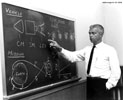Dear Lazzie
OpenLaszlo under a Bushel?
The difference between `.` and `[` in Javascript
Advice for the OpenLaszlo optimizer
More…
Peeves
Play
Thought for the day
Using your iPhone overseas without getting screwed
Label me 'optimistic'
Loose-lose proposition
More…
Wishes
Work
Pizza, Beer and OpenLaszlo [Part Deux]
Free as in beer, Open as in source
It's Fresh!
More…
Archives
2003-10-09
Shoot the Moon1
I’m travelling today to Champaign, Illinois to the University to participate in a celebration of my father-in-law, Dr. John C. Houbolt, who is donating his papers to the university library. John (whose pronounces his last name as if it rhymes with cobalt, despite what the university site says) is an unassuming man, his name is not the first that comes to mind when thinking about the moon landing2, but he was actually a key figure in our getting there.
Dr. Houbolt did not invent the concept of “Lunar Orbit Rendezvous”3, but he was an avid mathematician, and in researching and teaching himself orbital mechanics (in order to teach others, including the astronauts), he realized that the concept of orbital rendezvous (Earth or Lunar) had far-reaching ramifications in simplifying the task and reducing the cost of getting to the moon. He felt this idea was so important that it became his mission to champion the idea.
Dr. Houbolt promoted the concept of Lunar Orbit Rendezvous by demonstrating the weight and cost savings that would permit using existing booster technology, as opposed to the “direct ascent”4 method which relied on developing new boosters, or the Earth Orbit Rendezvous5, which required twice as many conventional boosters. Although he was mathematically sure his plan was the best, bureaucracy, politics, and fear (of losing the astronauts should the rendezvous in lunar orbit fail) hindered his proposal.
Eventually Dr. Houbolt had to resort to going around the chain-of-command to get his point across. Coincidentally, his actions occurred just as President Kennedy set the challenge to America to put a man on the moon before the end of the decade. Through Dr. Houbolt’s persistence, the bureaucracy was finally turned in the right direction, and at 16:17EDT on 20 July 1969, mankind first set foot on the Moon, using Houbolt’s Lunar Orbit Rendezvous plan.6
While John’s promotion of Lunar Orbit Rendezvous is perhaps his most well-known accomplishment, his career as Chief Aeronautical Scientist at NASA was long and productive. We have been told by the University, that his papers represent the foremost modern historical collection of their library.
1. Shoot-the-Moon is a game where you try to accelerate a metal ball up an inclined pair of rods, fixed at one end, by maneuvering the free end of rods apart and together, using gravity to accelerate the ball on its trajectory up the incline. It is aptly named, because our lunar excursions relied on the same principal: utilizing gravity to accelerate (and decelerate) the spacecraft for free.
2. The Moon Landing? Wasn't that a hoax? It may seem so to younger generations. After all, the first landing happened so long ago, you cannot even express it as a Unix date (which is defined as seconds since midnight, January 1, 1970). But we did send 12 astronauts to the moon in the late sixties and early seventies. We got so good at it, we even sent them up with a little “dune buggy” so they could tool around the craters and check things out.
3. The concept of using a staged vehicle to reduce the energy requirements for travelling between the planets goes back at least to the 1800's when a Russian mathematician described the process.
4. Direct ascent relied on building a gigantic rocket (code named Nova, never built) and essentially firing it directly at the moon, turning around half way out, and trying to slow down before you hit it. Just as Jules Verne had described in “From the Earth to the Moon”.
5. Earth Orbit Rendezvous involved making two or more flights from Earth that would be used to assemble (in orbit) a rocket to reach the Moon. This rocket would still approach the Moon as in direct ascent, but smaller boosters would suffice to escape the Earth's gravity, because the payload would initially be split in two.
6. A detailed review of Dr. Houbolt's contribution to the moon landing is available as NASA Monographs in Aerospace History Series #4 Enchanted Rendezvous.
Hey, I have one of those “Shoot-the-moon” games, except that it’s labelled “Control-o-ball”. It’s surprisingly popular with both children and adults.
does anyone know the physics behind the shoot to the moon game
Post a comment
Thanks for signing in, . Now you can comment. (sign out)
(If you haven't left a comment here before, you may need to be approved by the site owner before your comment will appear. Until then, it won't appear on the entry. Thanks for waiting.)





